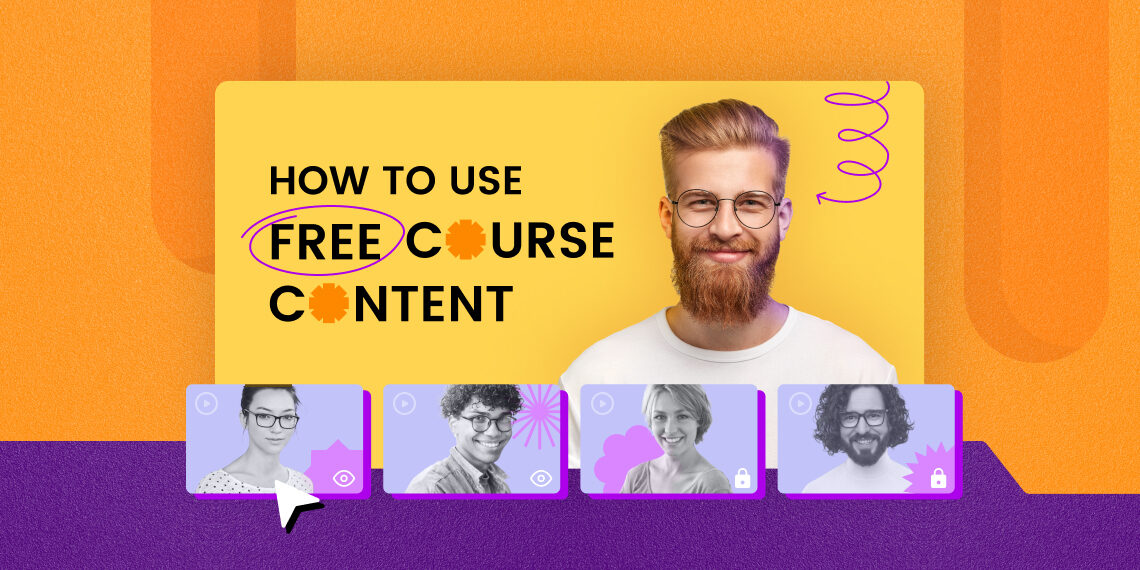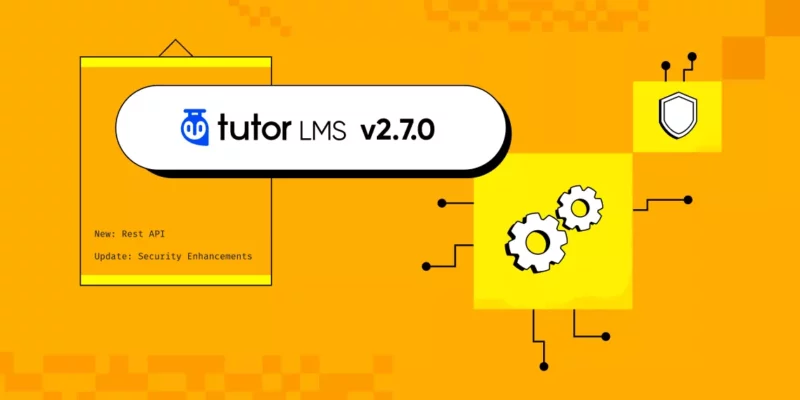Are you offering enough content for free? Why would you even give out your precious content for free anyway?
These are typical questions that every content creator has probably asked themselves at least once. Many eLearning businesses and entrepreneurs waver at the thought of giving away their content for free. It’s easy to see why free services don’t really generate profit or do they?
It is evident that free content won’t generate any immediate monetary return. However, there are a variety of other ways in which both you and your audience can benefit from free eLearning courses.
So let’s put our thinking caps on and learn the benefits free course content offers your business.
Why Should You Give Away Free, Valuable Content
This question always seems to spark a debate between course content creators. But in my opinion, the real question is how to strike a good balance between free and paid content.
Before we discuss which course should be free or paid, you need to understand the positive impacts of free course content.
1. To Grow Your Audience
Free courses mean free marketing for your business. Giving online learners a free eLearning course allows them to spread the word about your organization. It creates opportunities to increase web traffic, convert leads, make connections, and much more.
Although you will not profit from the free content directly, make sure they are of the highest quality and add value to learners. The feedback from learners will reflect on your professional image and help generate publicity.
2. To Demonstrate Your Value
Without knowing what to expect, potential learners will be reluctant to buy or enroll in a course you offer. However, these concerns can be swayed if they can see the quality of your work and that you are offering helpful information.
Free eLearning courses give the audience a good idea of what to expect when working with you. It generates more credibility for your organization and attracts more potential customers.
3. Build Customer Loyalty
Another huge benefit of creating free courses is generating loyal followers. The more prospects who read your content, the more you help them create value in their lives. In turn, your learners show gratitude by sharing your content through word of mouth, social networks, or purchasing other courses.
4. Acquire Valuable Feedback
When you publish a free eLearning course, you will most likely get a lot of feedback from your learners. Feedback is an excellent tool for improvement. It lets you know what learners really think about your content.
You can include surveys or questionnaires at the end of a course and encourage learners to offer their input. Using this data, let’s identify your weaknesses and improve upon them. Gathering feedback also lets you get testimonials and endorsements. These reviews can be showcased on your website to increase credibility.
5. Promotes Your Existing Course Archives
You can introduce other related courses or more advanced courses by linking them at the end of your free course. In this manner, your free eLearning course will serve as a gateway for your audience to learn about your other course.
6. Establish Yourself as an Expert on the Topic
Your free eLearning course allows you to prove your ability and knowledge on the topic. The more learners who are influenced by your content, the higher your authority status will get. This way, free content helps position you as an expert and authority on the topic.
The Elephant in the Room…
Let’s take a minute and talk about the elephant in the room. Yes, I’m talking about the so call pitfalls of giving out your best courses for free. Skeptics of free content will tell you that giving away content for free is a flawed strategy and that your business will suffer in the long run. The idea is that by giving away some of your best courses, your audience will always expect more free content from you. Also, it undervalues your work; others can copy your free content and sell it as their own.
Don’t let this skepticism get to you. Like many others, the eLearning market has two types of consumers. The first type only wants free courses, and the second is those eagerly waiting for your premium paid content to come out.
People who only consume your free content never have the potential to be converted to paid customers. But they serve a greater purpose by helping us boost our numbers and make our social accounts look healthy and populated. This helps us attract more paying customers.
The second type of customer are the ones eagerly awaiting to purchase our paid courses. Free course content helps us filter out the people who will never buy from us and helps us focus on the real customers.
How Do You Decide Which Content Should Be Free
Deciding what course content to offer for free can be pretty daunting. However, there is a simple strategy to make the decision more simple.
The simplest way is to divide the courses based on three different categories:
- Do it yourself
- Done with you
- Done for you.
“Do it yourself” courses are the ones usually priced the lowest. They typically include inspiration, possibilities, stories, opinions, and personal thoughts on the topic. Giving away courses that fall under this criteria helps you ignite interest in learners and keeps them wanting more.
The “Done with you” & ” Done for you” are the more expensive type of courses available. Charge for courses that show learners the process of something which they can replicate. Also, price courses that include training, customization, and information that empowers your audience. These are the kind of courses that offer the most value to learners and are something that free content alone cannot replicate.
Additionally, to make matters easier, you can opt for a top-of-the-line and modern Learning management system (LMS) like Tutor LMS. Let’s take a brief look at how Tutor LMS can help maximize your content delivery and management:
- Tutor LMS offers a comprehensive content management system that allows you to create, manage, and deliver your eLearning content in a variety of formats, such as text, video, and audio.
- Tutor LMS lets you create both free and paid courses. It has pre-built support for several popular e-commerce plugins like WooCommerce. This makes pricing, categorizing, and bundling your courses while running your own virtual marketplace a breeze.
- Additionally, Tutor LMS allows you to easily upload, edit, and remove any training materials and courses at any time, making the management of content flexible and easy.
How to Turn Free Content Into Sales
When learners enroll in your eLearning course, they start a learning journey. The job of an educator is to make the learning process as enriching as possible.
However, handing out all our knowledge for free isn’t great for business. This is why we need to find the right balance between delivering free content while keeping your eLearning course valuable. To achieve this balance, follow these three guidelines:
1. Call To Action
A rule of thumb is to ensure that your free content leads learners back to your website. It is not necessarily just your eLearning website. It can also be your Facebook or Amazon page, an online store, or any other place that displays all your courses.
You can achieve this by including a call-to-action (CTA) in your free content. They can look like: download now, buy here, trial offer, money back guarantee, limited time only, etc. The CTAs you use will also depend on your marketing approach. Still, the ultimate goal is to drive customers back to your primary web assets.
2. Retain Certain Information & Explanations
An ideal method to find the right balance between offering free courses while maintaining high value for paid courses is to withhold certain information and explanations. You can define concepts, ideas, and opinions in your free course without providing the whole explanation or know-how.
For example, let’s say you are creating a free course about proper nutrition and diet. Explain all the benefits and outcomes of healthy eating while withholding meal plans and healthy meal recipes.
Remember to inform your audience where they find the rest of the information. This can be done by linking related courses, as mentioned earlier.
3.After-sales Services
A great way to justify the price for your paid courses is to provide your audience with after-sales services. This can be in the form of personalized guidance, Q&A sessions, group discussions, or money return guarantees. The type of after-sales services you opt for will depend on your business model.
To help you manage your after-sales services, it is a great idea to use a modern top-of-the-line LMS such as Tutor LMS. Tutor LMS can help with after-sales services in a number of ways:
- Tutor LMS provides an easy way to manage and track customer support requests and inquiries.
- It has a built-in community system that allows customers to submit query requests, track progress, and receive updates on their posts.
- You can also use Tutor LMS to create and manage a knowledge base that customers can access to find answers to common questions.
- Tutor LMS allows you to set up automated workflows to help you manage customer support requests more efficiently. For example, you can send customers an automated email response when they submit a support request.
After-sales services are usually perceived as a sign of quality assurance by consumers. This helps prospective learners make purchasing decisions faster.
Conclusion
Free course content can greatly generate buzz for your business while increasing website traffic and brand awareness. It is a great strategy to penetrate the entry barriers in today’s competitive eLearning market.
To make life even easier, you can use a Learning Management System (LMS) to create, manage and sell all your courses from one place. Try Tutor LMS to experience the best content management system the internet has to offer for free.




SrinivasAjimera
Nice blog. I finally found a great post here Very interesting to read this article and very pleased to find this site. Great work!
https://espirittech.com/testing-and-qa-services/
SrinivasAjimera
Good Post! Thank you so much for sharing this pretty post, it was so good to read and useful to improve my knowledge as an updated one, keep blogging.
https://espirittech.com/react-js-services/
SrinivasAjimera
It’s really an excellent post. I just stumbled upon your blog and wanted to say that I have really enjoyed reading your blog. Thanks for sharing.
https://espirittech.com/data-labeling/
SrinivasAjimera
This was a wonderful post being shared. The entire content in this blog is extremely helpful for me and gave me a clear idea on the concepts.
https://espirittech.com/application-development/
SrinivasAjimera
Really enjoyed reading your article, the information you delivered in this post was damn good. Keep sharing your post with efficient news.
https://espirittech.com/testing-and-qa-services/
SrinivasAjimera
Good Post! Thank you so much for sharing this pretty post, it was so good to read and useful to improve my knowledge as an updated one, keep blogging.
https://espirittech.com/
SrinivasAjimera
I am impressed by the information that you have on this blog. It shows how well you understand this subject.
https://espirittech.com/ui-ux-development-services/
SrinivasAjimera
Awesome blog. I enjoyed reading your articles. This is truly a great read for me. I have bookmarked it and I am looking forward to reading new articles. Keep up the good work.
https://espirittech.com/offshore-php-development/
SrinivasAjimera
This is a great post I saw, thanks for sharing. I really want to hope that you will continue to share great posts in the future.
https://espirittech.com/best-node-js-development-services/
SrinivasAjimera
Nice blog. Thank you for sharing. The information you shared is very effective for learners, I have got some important suggestions from it
https://espirittech.com/codeigniter-development-services/
SrinivasAjimera
Hi there, you have performed an excellent job. I will certainly dig it and individually suggest it to my friends. I’m confident they will be benefited from this website.
https://espirittech.com/wordpress-development-services/
SrinivasAjimera
I am reading your post from the beginning, it was so interesting to read & I feel thankful to you for posting such a good blog, keep updates regularly.
https://espirittech.com/laravel-development-company/
Shah Asif
Thank you so much for your kind words! We’re glad that you’re enjoying our blog and appreciate you taking the time to read it from the beginning. We’ll definitely keep updating it regularly with more interesting content. Thanks for your support!